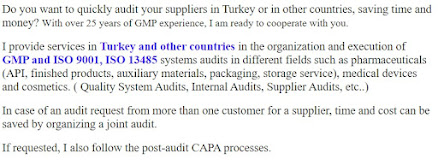- Get link
- X
- Other Apps
1. Facility Design and Maintenance
- Cleanliness: The facility must be clean and organized, with defined zones for various stages of production.
- Layout: The design should minimize the risk of cross-contamination (e.g., separate areas for raw materials, production, and packaging).
- Maintenance: Equipment, walls, floors, and ceilings should be well-maintained and made of materials that are easy to clean and resistant to chemicals.
2. Quality Management System (QMS)
- Documentation: Ensure that all manufacturing processes, quality controls, and deviations are documented clearly.
- Corrective and Preventive Actions (CAPA): Inspect how the facility manages deviations and corrective actions.
- Change Control: Verify if any changes in production or processes are documented and assessed for risks before implementation.
3. Personnel Training and Hygiene
- Training: Staff should be well-trained, with regular updates on procedures, safety protocols, and GMP regulations.
- Personal Hygiene: Inspect staff hygiene practices, including hand-washing stations, protective clothing, and policies regarding food, drink, and personal items in production areas.
4. SOPs and Batch Records
- Standard Operating Procedures (SOPs): Ensure that clear, updated SOPs are in place and are being followed.
- Batch Records: Batch manufacturing and packaging records must be complete, accurate, and regularly reviewed. Every batch of drug product should have a traceable record of its entire production cycle.
5. Equipment Qualification and Calibration
- Qualification: Equipment should be appropriately qualified (Installation, Operational, and Performance Qualification) before use.
- Calibration: Regular calibration schedules should be maintained for all critical equipment, with documented proof of compliance.
6. Raw Materials and Supply Chain
- Material Receipt and Storage: Ensure proper procedures for receiving, inspecting, and storing raw materials to prevent contamination or degradation.
- Supplier Qualification: Verify that raw material suppliers are qualified and assessed regularly for compliance with GMP standards.
- Labeling and Traceability: Raw materials must be labeled correctly, and records should allow traceability through the entire supply chain.
7. Validation and Process Controls
- Process Validation: Verify that manufacturing processes are validated to consistently produce products that meet predetermined specifications.
- Critical Control Points: Identify and inspect the control of critical parameters like temperature, pressure, and mixing times.
- In-Process Testing: Evaluate procedures for in-process testing, ensuring it is conducted to prevent errors or deviations during manufacturing.
8. Environmental Monitoring and Contamination Control
- Environmental Monitoring: Ensure regular testing and monitoring of air quality, water, and surfaces to detect any potential contamination.
- Cleanrooms and Controlled Areas: Ensure proper maintenance of air filtration systems (HEPA filters), pressure differentials, and cleanliness in controlled areas.
- Microbial Testing: Inspect microbial monitoring procedures for both personnel and the environment.
9. Product Testing and Release
- Quality Control (QC) Testing: Finished products should undergo quality control testing (chemical, physical, and microbiological) to ensure they meet specifications.
- Release Criteria: Check the criteria for releasing products for sale, ensuring that they meet all necessary quality requirements and are approved by qualified personnel.
- Retention Samples: Inspect retention sample practices to ensure adequate storage and traceability for future reference.
10. Handling of Complaints and Recalls
- Complaint Handling: Ensure there is a robust system in place for handling and investigating product complaints.
- Product Recalls: Check if the facility has clear procedures for initiating, managing, and documenting product recalls if necessary.
11. Data Integrity
- Electronic and Paper Records: Inspect the management of electronic and paper records to ensure data integrity (no unauthorized changes, complete audit trails, etc.).
- Audit Trails: For electronic systems, verify that audit trails are in place to track changes to critical data.
- Archiving: Ensure proper storage and accessibility of records, including backups, for the required retention period.
12. Packaging and Labeling Controls
- Labeling Accuracy: Ensure that labels accurately reflect the product contents and regulatory information.
- Packaging Integrity: Inspect packaging to ensure it is designed to protect the product from contamination or damage and prevent counterfeiting.
- Segregation: Ensure that different products, including different strengths or forms, are clearly segregated to avoid mix-ups.
13. Storage and Distribution
- Storage Conditions: Verify that storage areas are climate-controlled as required for specific drug products (temperature, humidity, etc.).
- Distribution Practices: Inspect the facility’s distribution practices to ensure products are transported in compliance with their storage requirements and tracked for traceability.
14. Handling of Deviations and OOS (Out of Specification) Results
- Deviations: Evaluate how the facility handles deviations from standard processes, ensuring proper documentation, root cause analysis, and corrective actions.
- Out of Specification (OOS) Investigations: Check procedures for investigating OOS results, including root cause analysis and risk assessments.
15. Waste Disposal and Environmental Impact
- Waste Management: Inspect how the facility handles and disposes of hazardous waste and ensures that it does not contaminate the environment or the product.
- Environmental Impact: Evaluate the facility's procedures to mitigate any environmental impacts, such as emissions or water discharge.
16. Security and Restricted Access
- Access Controls: Inspect controls to restrict access to production, storage, and quality control areas to authorized personnel only.
- Security Systems: Ensure the facility has appropriate security measures (e.g., cameras, alarms) to prevent tampering or theft of products.
By focusing on these areas during a GMP inspection, you can ensure that the facility meets regulatory requirements, ensuring the safety, efficacy, and quality of the drugs being produced.
Contact information
Mail: turk.avci@gmail.com
Linkedin profile: Murat Avcı | LinkedIn


Comments
Post a Comment